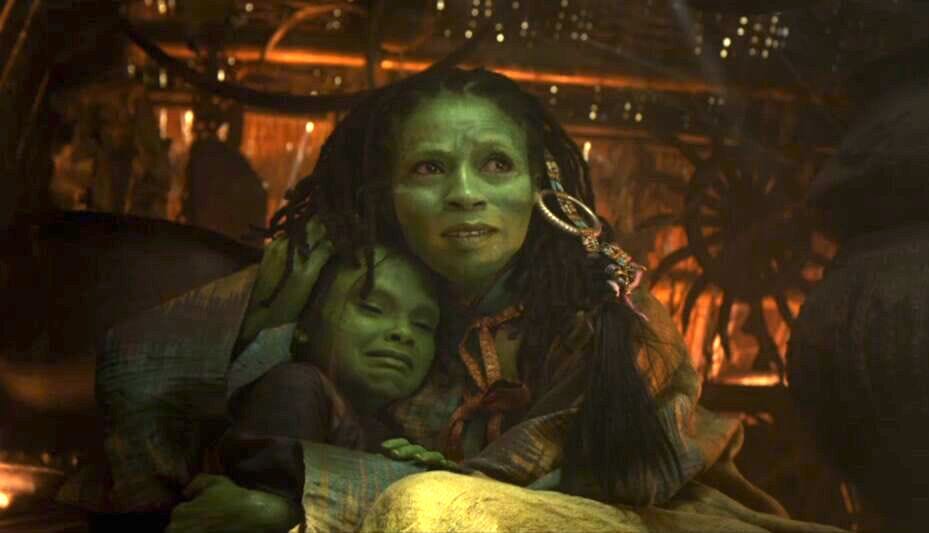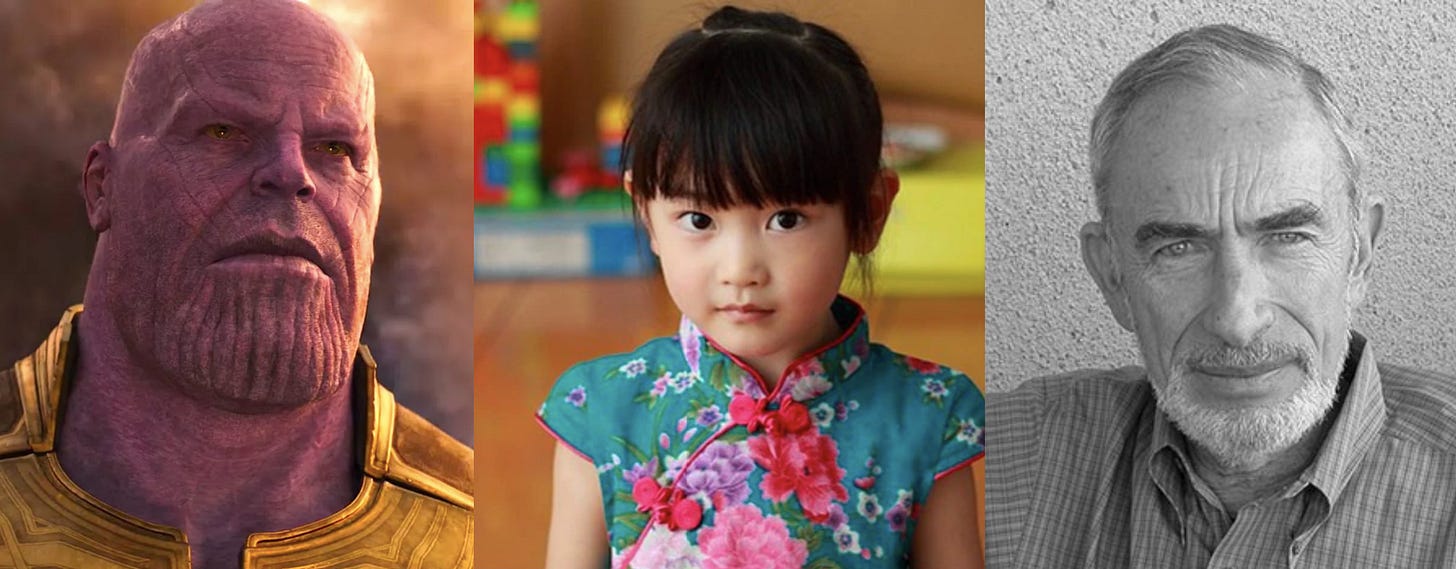Thanos, Ehrlich and the Lost Daughters of China
China claims to have prevented 400 million births with its One-Child Policy. With an estimated 100 million forced abortions and sterilizations, women are the prime victims of Ehrlich's ideology.
In Avengers: Infinity War, Thanos murders half of the population on the planet Zen-Whoberi in his quest to bring balance to the universe. The young girl Gomora is being hidden by her mother but both are discovered and then her parents are killed in front of her. Thanos is impressed with Gomora’s fighting spirit and decides to save her in order to turn her into his personal assassin. He tells her:
“it's a simple calculus. This universe is finite, its resources, finite. If life is left unchecked, life will cease to exist. It needs correcting.”
When she eventually learns of her tragic future, she turns against him and says, “I’m not your daughter. Everything I hate about myself, you taught me.”
Thanos acquires the infinity stones and with the snap of his fingers, turns half the population to dust. He's achieved his goal, but people still remember the old world and their lost friends and family members. They lack the “proper” appreciation. His new plan now is to completely destroy the universe and build a new one. “A grateful Universe” that has no memory.
Thanos was introduced in February of 1973 as a fictional character in a comic book. Where did his creators, Jim Starlin and Mike Friedrich, get their ideas for this ideology? In 1968 Paul Ehrlich published The Population Bomb and claimed that population growth would result in mass starvation. More recently, Ehrlich argued that “You can’t go on growing forever on a finite planet. The biggest problem we face is the continued expansion of the human enterprise.” Ehrlich’s early work launched a frenzy of studies, books and articles concerning the supposedly negative relationship between population growth and resource scarcity. Two of them, The Club of Rome’s The Limits to Growth (1972) and The Ecologist’s A Blueprint for Survival (1972), were taken seriously by the Chinese Communist Party.
Ehrlich is also notorious for his losing bet with economist Julian Simon in the 1980s. Ehrlich claimed that as population increased that resources would be depleted and civilization would become extinct. He wrote that:
“Society needs rescaling – we’ve got to reduce the size of the entire human enterprise.”
Simon argued the complete opposite, that resources would become even more abundant as population and liberty increased. He claimed that people were the “ultimate” resource. They entered into a ten-year bet on September 29, 1980 on five metals; copper, chromium, nickel, tungsten, and tin. The basis of the bet was $1,000. On October 11, 1990 Ehrlich mailed Simon a check for $576.07. The inflation-adjusted prices on all five metals had dropped by an average of 36 percent.
Four days before Simon and Ehrlich made their bet, the Chinese Communist Party issued a public letter on September 25, 1980 officially imposing their One-Child policy. Award-winning journalist Charles C. Mann reports that the birth limit “led to huge numbers—possibly 100 million—of coerced abortions, often in poor conditions contributing to infection, sterility and even death. Millions of forced sterilizations occurred [as well].”
China’s National Population and Family Planning Commission, which was tasked with implementing the One-Child policy, grew into a gigantic bureaucracy with half a million full-time employees and 85 million part-time employees. Ehrlich got his army. According to the Chinese government itself, the policy prevented 400 million births.
In a very real sense, Ehrlich was Thanos and China was his universe. The primary victims of Ehrlich’s policy recommendations were females. Mothers suffered, and the Chinese cultural preference for sons meant that girls were aborted more often than boys. It is estimated that there were 34 million more men than women in China in 2018.
Anthropologist Susan Greenhalgh argues in her book, Just One Child, that the policymakers “knew the one-child would lead to the culling of girl infants from the population, but that they actually saw this as a feature, not a bug. Selective culling of females meant fewer future mothers, meaning the ratcheting down of birth rates would be baked into future trends.”1
The 2019 Sundance U.S. Grand Jury Prize-winning documentary film One Child Nation explores the devastating impacts of China’s one-child policy, uncovering one shocking human rights violation after another — from abandoned newborns (almost always girls), to forced sterilizations and abortions to government abductions. Featured is a midwife who estimates that she performed 60,000 abortions and sterilizations while the policy was in effect. Ehrlich has to be proud.
Like Gomora’s mother trying in vain to protect her young daughter from the massacres of Thanos, millions of Chinese mothers attempted to protect their children from the vast armies of weaponized population control enforcers inspired by Ehrlich.
One particularly horrifying example of the policy was reported by Mei Fong, Pulitzer Prize-winning journalist and China correspondent for the Wall Street Journal. Feng Jainmei was a 22 year old factory worker who was hooded and abducted by seven people and then forcibly injected to induce an abortion. The couple had failed to meet demands for 40,000 yuan (four years of salary) for breaking birth control rules. A photo of her lying next to her almost fully-formed aborted baby girl went viral and took the One-Child Policy debate nationwide.2
Policy Reversals Are Too Late
In 2015, the Chinese Communist Party recognized the demographic nightmare they had created and replaced their one-child policy with a two-child policy.3 Ehrlich was incensed. He tweeted (in all caps): “GIBBERING INSANITY – THE GROWTH-FOREVER GANG.”
While birthrates did climb somewhat, they slipped back in a few years creating more worries for China’s population control planners. On May 31, 2021 the Chinese Communist Party announced a new three-child policy.4 Quite a reversal, but it may be too late to make any difference.
Texas A&M Professor Valerie Hudson who directs the Program on Women, Peace, and Security wrote in response to the demographic abyss facing China, “I would not be surprised in the least if, within the near future, China imposed a birth quota of two or three children per couple.”5 China may go from forcing abortions to mandating births.
Conclusion
Unlike Ehrlich, who has shown no compassion for women in China, at least Thanos had a moment of mercy for the young green-skinned girl Gomora. Ehrlich’s apocalyptic forecasting skills also failed miserably. Since his bet with Simon in 1980, global population has increased by almost 75.8 percent from 4.45 billion to over 7.8 billion today adding 3.35 billion human beings to the planet. During this same period we’ve enjoyed an estimated 608 percent increase in commodity abundance.6 More people are creating much much more abundance for the rest of us, if they have the freedom to learn and innovate.
How many Marie Curies, Oprah Winfreys, and Malala Yousafzais did China and the rest of the world lose under Ehrlich’s policies?
Ehrlich only lost $576.07 to Simon, but China was the the big loser, missing 200 million daughters, sisters, and mothers. Only by rejecting the false and deadly ideology of scarcity as promoted by Ehrlich and Thanos can humanity flourish and avoid China’s womanless destiny.
Excerpt from our forthcoming book, Superabundance.
Gale Pooley is a Senior Fellow at the Discovery Institute and a board member at Human Progress
https://ifstudies.org/blog/chinas-karmic-demographic-mess
Fong, M. (2017). One Child: The Story of China's Most Radical Experiment. London: Oneworld Publications, p. 61
https://www.abc.net.au/news/2015-12-27/chinas-one-child-policy-officially-scrapped/7055834
https://www.indiatoday.in/world/story/china-three-child-policy-changed-1808997-2021-05-31
https://ifstudies.org/blog/chinas-karmic-demographic-mess
https://www.humanprogress.org/the-simon-abundance-index-2021/







